Spring has sprung. Water temperatures are on the rise—as is the activity of the koi in the water. It is an exciting time for those koi keepers who have had to endure those cold months when their living jewels have basically been invisible.
It is also when conditions are prime for spring algae blooms. These can be a major source of irritation for koi owners who just want to see their fish.
However terrible it looks, it is not cause for massive concern—especially in the early season. Although your pond is a closed system, if your biological filter is big enough to handle the fish load and water volume, and is working correctly, the natural cycle of the pond and the beneficial bacteria it produces will spring back to life. And with a little help, the bloom can be cleared up fairly quickly.
Algae?! Why?!
Algae thrive off the types of matter that you will typically find in almost every koi pond at one time or another. It is a three-part cocktail of sunlight, CO2 (Carbon Dioxide) and food (in this case nitrates).
In the springtime, there is often enough of all three to give an algae bloom all the help it needs to get a proper foothold.
Types of Algae
There are two main types of algae growths that koi keepers can expect to battle at some point.
1) Green Water
This is the bane of a koi keeper’s pond visibility. As the most commonly combated type of algae in a spring bloom, it is an extremely fast growing microscopic, single-celled phytoplanktonic algae. Your pond can go from clear to pea soup in two days.
It floats on or near the surface of the pond and looks like pea soup in the pond (although it can be brown and sometimes reddish).
2) String Algae
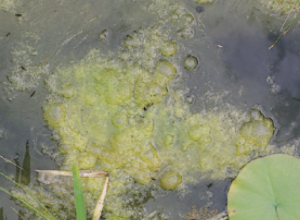 This filamentous (string-like) algae grows in strands, attaching to the bottom of the pond on waterfalls as well as streams. When it breaks off and floats to the surface is when koi keepers have the major pond scum headache.
This filamentous (string-like) algae grows in strands, attaching to the bottom of the pond on waterfalls as well as streams. When it breaks off and floats to the surface is when koi keepers have the major pond scum headache.
String algae is more of a slow grower. So slow in fact that it can be dormant for long periods of time in a dried form. When it isn’t clogging your filters and pumps as a thin coat on your pond’s walls and floors, it has actual value to the pond by consuming nitrates and releasing oxygen.
And no, you can’t just rip it out. Doing so releases its spores back into the water and the struggle continues.
Algae Giveth And Algae Taketh Away
It may be irksome but it does have some good qualities and some that are more harmful than simply blocking your view. Here are some of the pluses and minuses of algae in a koi pond:
(+) Pluses
As we have already stated, algae is not always a terrible thing to have in your pond. It is a natural nitrate filter. It’s better as a carpet than a ceiling, though.
Algae, and especially the filament variety, plays a part in helping to limit the number of nitrates in the pond by consuming them. It also helps with phosphates (which, ironically, is one of the reasons for the early spring bloom).
It is also a ready snack for your koi, who will eat just about anything.
(-) Minuses
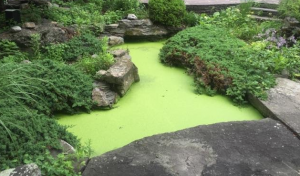 The obvious downside to having algae in a koi pond is the visibility. Koi are beautiful fish—hence the handle Living Jewels. Having their natural beauty muted under murky or algae-covered waters just plain sucks.
The obvious downside to having algae in a koi pond is the visibility. Koi are beautiful fish—hence the handle Living Jewels. Having their natural beauty muted under murky or algae-covered waters just plain sucks.
There are other potential hazards from algae, however, especially to do with oxygen levels. It is true that algae creates oxygen during the daytime as a by-product of photosynthesis; however, at night it consumes just as much—if not more—than it produces. Large algae blooms in koi ponds can cause a dangerous enough drop in oxygen that it can result in koi death.
Additionally, algae begets more algae (i.e. as it dies it feeds the next generation) and if not properly dealt with will continue to proliferate.
It can also end up in pumps and filters, clogging them and potentially damaging the equipment, as well as creating a cleaning headache for koi keepers.
Causes of Algae Blooms In Koi Ponds
In many instances, both types of algae result from poor or insufficient filtration and/or beneficial bacteria that hasn’t had a chance to proliferate fully to the levels that can help to keep the nitrates out of the pond.
Here is a more comprehensive checklist of the potential causes of algae blooms in koi ponds.
Pond Construction
Believe it or not, the shape and construction of your pond may be a contributing factor to algae blooms in your pond.
Having a graduated bottom with varying depths with the majority of the surface area being deeper than the other areas can help with cleaning and debris removal.
According to the water garden, it should be 40% deep, 30% intermediate and 30% shallow.
The materials used in the pond’s construction can also contribute to the likelihood of spring algae bloom. Stuff like marble, concrete and limestone will increase the pH level, making it more algae friendly.
Pond Age
The age of your koi pond can also contribute to the likelihood of an algae bloom. Newer, unseasoned ponds that haven’t had the time to grow a big enough crop of beneficial bacteria are usually more susceptible to an algae bloom.
Lack of shade
Algae uses photosynthesis to sustain itself. The more sun it gets the easier it is for the algae to grow and grow and grow.
Incomplete clean
For those koi keepers that go through the fall clean, getting rid of all those organic compounds that may have settled at the bottom of the pond is important. Too many nutrients left over after winter will help an algae bloom by providing the nitrates it feeds on.
Too Much, Too Soon
You have probably noticed a pattern here regarding how nitrates and decaying organic compounds contribute to spring algae blooms in koi ponds. So it probably comes as no surprise when we tell you that overfeeding your koi in spring is not a good idea. Any uneaten food that is not removed eventually becomes a feast for algae.
Runoff
With melts and big rains, anything that is on the ground, or has been used to treat your yard, can end up in your pond.
Things like fertilizer or other lawn care products (as well as other organic flotsam) carry those nutrients that algae love into the water when washed in. Phosphates, used in fertilizer, is another algae favorite.
Limiting the amount of runoff (which has a lot to do with pond location) is helpful in not contributing those natural foodstuffs that algae use to grow.
Solutions to Algae Blooms in Koi Ponds
 Netting
Netting
This is a useful preventive measure used by many koi keepers in the fall and winter. Stretched across a pond, it reduces the amount of debris that turns into organic compounds on the bottom of ponds.
This, in turn, reduces the amount of dissolved organic compounds (specifically nitrates) that will feed the algae bloom.
Take a look at this post on koi pond netting, their sizes, styles, and uses.
Shade
Go ahead and throw some! Algae LOVES sunlight. Even if you have trees, they won’t offer the type of natural shade that is needed until they have fully bloomed. You might need to get a temporary cover for the pond until any natural shade is back up and running.
Some shade options are:
- Pond dyes
- Sail cloths
- Floating pond plants
Cleaning
There is some debate about whether or not this is necessary in the spring, but if you do have a pretty big post-winter buildup of organic material on the floor of your pond, getting rid of it can help to lessen the chance of an algae bloom.
Vacuum the bottom if there is a buildup of leftover debris and net anything that is floating. If you have a skimmer installed, that will be helpful in minimizing floating debris. But make sure to clean it as well.
Water Changes
This is the natural first line of defense for pond keepers. And it is no different with trying to prevent algae blooms in koi ponds.
Water changes introduce fresher water to the pond and reduce the amount of nutrient-laden water already in the pond. Don’t overdo it, however. Your koi are still coming around after a long winter of little activity and an immune system that is not operating at 100%. Gradual water changes will be more helpful in not stressing the water parameters or the koi.
Overfeeding
As much as you want to feed your koi in spring, make sure you aren’t adding more dip to the algae party. Limiting the number of feedings or food during those feedings goes a long way to keeping organic compounds out of the water that can turn into a food source for algae.
Ultraviolet light
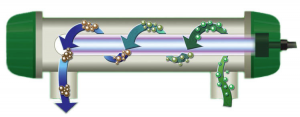
UV filtration is a popular way of helping to combat the single-celled phytoplanktonic green water algae. The UV rays damage the reproductive capabilities of the algae cell so that it cannot replicate.
As a bonus, UV filters are also effective in removing other potentially harmful free-floating bacteria.
UV Light wattage is rated according to pond size and volume, so be sure to learn the adequate amount of watts you will need.
Oxygenate
Gotta love oxygen. No, really. You gotta love oxygen. When you have an algae bloom, proper aeration can mean the difference between live koi and dead koi.
Getting oxygen into the water makes the environment a little less hospitable for the algae and the bloom.
The oxygenation will feed the algae, but it will also help to fire up the aerobic (oxygen-using) bacteria and get them up and running quicker.
Additionally, bubbling air through your pond is a great way to bubble CO2 to the surface and out the water—removing one of the components that algae thrive on.
Ways of Oxygenating
Oxygen exchange happens at the pond’s surface. Circulating the water and/or disrupting the water’s surface speeds up and enables the exchange. Here are some of the more common means of oxygenating koi pond water:
- Airstones
- Waterfalls
- Water jets
- Fountains
- Air pumps
There are benefits and “downsides” to all of them. Do a bit of research as to which is better for your particular koi pond’s situation.
Beneficial Bacteria
If your beneficial bacteria is up and running at optimum levels, it plays a large part in minimizing algae growth. As it consumes the same waste product (nitrate) that algae does, the more functioning aerobic bacteria there is, the more competition for resources there will be.
The absence or lack of this good bacteria is one of the reasons that early-spring blooms are more likely. With no natural means of slowing the algae’s growth, it will proliferate.
Beneficial bacteria will naturally proliferate. It just needs a little help and some time. Cleaning and prepping your pond filters early spring is helpful.
Some koi keepers will add beneficial bacteria to their pond water in the hopes of giving it a boost—a practice that fuels debate amongst hobbyists
Aquatic Plants
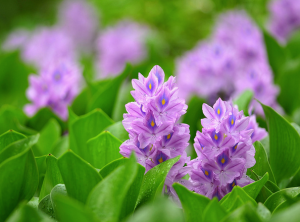
Floating aquatic plants (water hyacinths, water lily, lotus, water lettuce, water poppy) have numerous benefits, and particularly when helping to hinder algae blooms.
- Shade – helps to keep the water cooler as the temperatures rise, removing one of the essentials for algae to proliferate.
- Sunlight – Floating plants will also block the sun’s rays, limiting the capacity for photosynthesis—another necessary component for algae growth.
- Nutrients – aquatic plants will compete with the algae for the same type of nutrients that helps it to grow more quickly.
Additives
This is always a hot topic of debate amongst koi keepers. The desire to see their koi through the pea soup or strings of algae can often be enough of an impetus to “help” the natural process along.
There are a number of advertised products, whose advantages list adding or boosting bacteria and enzymes. Barley straw is another popular algae-fighting product.
If additives or any other form of algaecidal chemicals are used, caution is always advised. They will affect all plant life in your pond, not just the algae.
Know the proper dilution rates corresponding to the size of your pond. Adding the incorrect amount can have far worse results than the algae does.
With a little time and some proper prior planning, the likelihood of algae blooms can be minimized significantly and your pond water will be a lovely window to the koi that swim beneath.

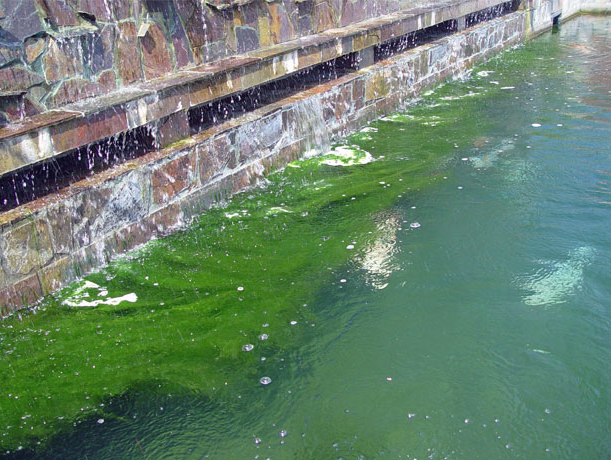
I have a 3000 gal pond, what is a sufficient amount of UV power and filtration?
I’m using a 2600 gal 13 watt gravity filter and a 1500 gal 13watt fountain filter as well is this enough for my pond? and I also have 12 4-6 inch koi/goldfish in my pond that I feed (not over feed) every night!
My pond is 2,700 gal and I use a 40 watt uv light most of the year. I have a second 40 watt that I use in the spring when the algae gets going – I only use the second uv for a few weeks to get the water nice and clear. I have the pondmaster brand and have been pleased with it. My filtration is much larger so I only have 1/6 of the water go through the uv light so that the water is exposed to the uv light for a longer period. Pondmaster has some flow recommendations on their website. good luck, I do enjoy clear water.
we’re having algie problems Your information helped. We have a 2500 gallon tank with a 35 ward uv light.
My issue is with string algae in a new pond/waterfall. It is in full sun. The concern is the algae continually blocks up the pump. It’s not that easy for me to clean. Should I order a bunch of pump covers and change it every few days? Please give me some suggestions, I’d so appreciate some help. Thanks
Hi Cathy,
While you can certainly order a bunch of pump covers and change them every few days, this can become time consuming and less cost effective. Two of the better suggestions would be to invest in some shading covers like sail cloths or tent. The other and usually more effective option is to invest in and install a UV Sterilizer or filtration. We recommend contacting an Aquascape Pond Builder or Certified Aquascape Contractor in your area. They are much more knowledgable with pond builds and maintenance. You can try finding one via the link provided below.
https://www.aquascapeinc.com/find-aquascape-certified-contractors
Thank you.
[…] https://nextdaykoi.com/koi-fish-facts/spring-algae-blooms-koi-pond-causes-combat/ […]
[…] https://nextdaykoi.com/koi-fish-facts/spring-algae-blooms-koi-pond-causes-combat/ […]